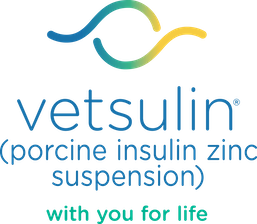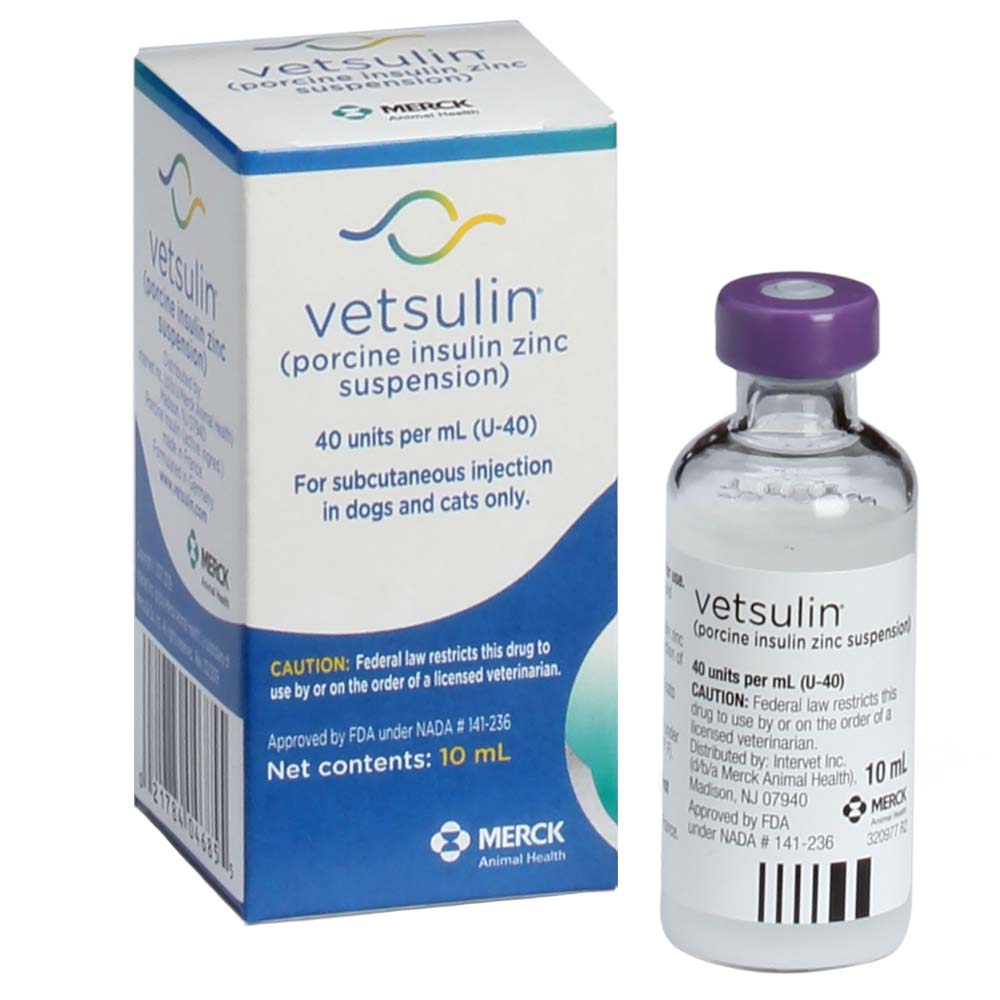

Frequently Asked Questions
Choose Vetsulin for exceptional professional support.
Questions about Vetsulin®

What is Vetsulin® (porcine insulin zinc suspension)?
The first insulin approved by the US Food and Drug Administration for treating both canine and feline diabetes mellitus. Vetsulin® (porcine insulin zinc suspension) is produced by Merck Animal Health and is available only by prescription.
Is this a brand new insulin?
No, Vetsulin is registered in over 30 other countries as Caninsulin®. It was first registered in Australia in 1990, so there is a history of more than 25 years of safety and efficacy with this product.
Is Vetsulin made here in the US?
No, Vetsulin is manufactured by Merck Animal Health in Germany.
What type of insulin is Vetsulin?
Vetsulin is an intermediate-acting, lente insulin containing 40 IU per mL of highly purified porcine insulin. As a lente insulin, Vetsulin is an aqueous suspension containing 35% amorphous and 65% crystalline zinc crystals in a neutral buffer of pH 7.35.
Can Vetsulin be diluted?
No. Vetsulin is a mixture of amorphous (soluble) insulin and crystalline insulin. The crystalline part is relatively insoluble, which is why the insulin activity lasts more than a few hours. Vetsulin has a balance between the amorphous and crystalline parts. If Vetsulin is diluted, the balance between amorphous and crystalline parts is no longer 35% and 65%, relatively speaking. The amount of soluble insulin is increased by the aqueous diluent used. This results in an alteration of the pharmacokinetics of Vetsulin. With a larger aqueous fraction and smaller crystalline fraction, there would be a decrease in the crystalline portion responsible for the second peak of insulin activity.
Can I use 100 IU syringes with Vetsulin?
No, use of a syringe other than a U-40 insulin syringe will result in incorrect dosing. Using a U-100 syringe with Vetsulin would result in an animal receiving 2½ times less insulin than required. Human insulins are formulated at a concentration of 100 IU/mL. If clients use a U-40 insulin syringe with a 100 IU insulin preparation, they would be injecting 2½ times the amount of insulin necessary, which could result in fatal hypoglycemia.
How does Vetsulin differ from human insulin products?
Vetsulin porcine insulin has the same amino acid sequence as natural canine insulin, whereas the commonly prescribed biosynthetic human insulin has a different amino acid sequence. The similar structure may provide more effective regulation of blood glucose and decreases the risk of anti-insulin antibody development in dogs. Unlike the dog, anti-insulin antibodies do not appear to be a problem in cats.
Why choose Vetsulin over human insulin for diabetic dogs and cats?
Vetsulin facilitates a more optimal treatment protocol than current human insulin products.
– Where biosynthetic human insulin is only available in 100 IU/mL concentrations, Vetsulin has a 40 IU/mL concentration allowing for more accurate dosing of small animals and reducing the risk of under- or overdosing.
– Vetsulin is administered with U-40 insulin syringe or VetPen®, making it easier for the client to read and deliver the dose.
– The duration of activity may be longer.
What issues might a dog or cat encounter when switching from human insulin to Vetsulin?
Caution should be exercised when changing from one insulin product to another. Any change in insulin should be made cautiously and only under a veterinarian’s supervision. Changes in insulin strength, manufacturer, type, species (animal, human), or method of manufacture (rDNA versus animal-source insulin) may result in the need for a change in dosage.
How is Vetsulin distributed?
To order Vetsulin, contact your Merck Animal Health sales or distributor representative. For more information, or for technical support, call 800-224-5318 on weekdays.
How long can Vetsulin be used?
Contents of Vetsulin vials and cartridges should be used within 42 days of first puncture.
Vetsulin® For Dogs
How does Vetsulin work in dogs?
A lente (intermediate-acting) form of insulin, Vetsulin contains 35% amorphous insulin for rapid onset of activity, usually peaking 4 hours after injection and lasting 8 hours. The remaining 65% of the formula is crystalline insulin which is absorbed more slowly and peaks around 11 hours after administration. The Vetsulin formula allows for a more continuous utilization of glucose to support the body’s basic functions. Vetsulin is administered subcutaneously once daily initially, although two-thirds of dogs require twice-daily administration for effective diabetes management.
What results typically can be expected from Vetsulin therapy in dogs?
Dogs in clinical trials responded to porcine insulin in the following ways:
– Substantially reduced mean 12-hour blood glucose concentration and mean blood glucose nadir post treatment, compared to pre-treatment levels.
– Reduced incidence of polyuria, polydipsia, and ketonuria in most dogs.
– Adequate blood glucose control in most dogs with less than one-third having hypoglycemic episodes.
How often does Vetsulin need to be administered in dogs?
Initially, the dose should be given once daily concurrently with or right after a meal. The veterinarian should reevaluate the dog at appropriate intervals and adjust the dose in 10% increments based on clinical signs, urinalysis results, and glucose curve values until adequate glycemic control has been attained. Approximately one-third of diabetic dogs can achieve successful diabetes management with a single dose of Vetsulin per day.
Twice-daily therapy should be initiated if the duration of insulin action is determined to be inadequate.
If twice-daily treatment is initiated, each of the two doses should be 25% less than the once-daily dose required to attain an acceptable nadir. The treating veterinarian would need to determine the frequency of a patient’s dose.
Can Vetsulin really be used only once daily in dogs?
Clinical studies have demonstrated that approximately one-third of dogs can be maintained adequately on once-daily doses of Vetsulin. The other two-thirds of dogs will require twice-daily administration of Vetsulin.3,4
How does Vetsulin differ from the human insulin products traditionally prescribed for dogs with diabetes?
Vetsulin has the same amino acid sequence as natural canine insulin, whereas the commonly prescribed biosynthetic human insulin has a different amino acid sequence. The similar structure may provide more effective regulation of blood glucose and decreases the risk of anti-insulin antibody development.
How many dogs currently have diabetes?
It is estimated that up to 23.6 per 10,000 dogs suffers from the signs of diabetes mellitus.15
Vetsulin® For Cats
How does Vetsulin work in cats?
Vetsulin is a lente (intermediate-acting) form of insulin that contains 35% amorphous insulin for rapid onset of activity. In cats, the peak activity following subcutaneous administration of Vetsulin occurs between 1.5 and 8 hours (with an average of about 4 hours), and the duration of activity varies between 8 and 12 hours. This is why, in cats, Vetsulin is initially administered twice daily rather than once daily1.
What results typically can be expected from Vetsulin therapy in cats?
In the Vetsulin feline efficacy study, cats were initially started on 1 to 2 IU of Vetsulin per injection twice daily. Glycemic control was evaluated based on blood glucose curves and clinical signs. Adjustment of the Vetsulin dose was made according to average blood glucose curve levels, blood glucose curve nadirs, and clinical improvement. At the end of the study, the mean Vetsulin dose was 3.3 IU per injection twice daily with a maximum dose of 8 IU per injection twice daily. Five percent of the cats in the study went into remission.2
Test cats demonstrated significantly lower blood glucose levels and a reduction in hyperglycemic clinical signs compared with pretreatment levels.
How often does Vetsulin need to be administered in cats?
In cats, the initial recommended dose is 1 to 2 IU per injection, and the injections should be given twice daily at 12-hour intervals. So, unlike in the canine where initial dosing is based on body weight, dosing of Vetsulin in the feline is based on a per animal basis. The duration of activity of Vetsulin in the cat is shorter than in the dog, ranging between 8 to 12 hours. Peak activity level occurs between 1.5 to 8 (average of about 4) hours in the cat.
How many cats currently have diabetes?
Estimates of the incidence of diabetes mellitus in cats is 68 per 10,000.15
*Vetsulin® is sold as Caninsulin® outside of the United States.
Important Safety Information:
Vetsulin® should not be used in dogs known to have a systemic allergy to pork or pork products. Vetsulin is contraindicated during periods of hypoglycemia. Keep out of reach of children. As with all insulin products, careful patient monitoring for hypoglycemia and hyperglycemia is essential to attain and maintain adequate glycemic control and prevent associated complications. Overdosage can result in profound hypoglycemia and death. The safety and effectiveness of Vetsulin in puppies, breeding, pregnant, and lactating dogs has not been evaluated. See package insert for full information regarding contraindications, warnings, and precautions.
VetPen® User Safety Warning: For use in animals only. Keep out of the reach of children. Avoid contact with eyes. In case of contact, immediately flush eyes with copious amounts of water for at least 15 minutes. Accidental injection may cause clinical hypoglycemia. In case of accidental injection, seek medical attention immediately. Exposure to the product may induce a local or systemic allergic reaction in sensitized individuals.
References:
1. Martin GJ, Rand JS. Pharmacology of a 40 IU/ml porcine lente insulin preparation in diabetic cats: findings during the first week and after 5 or 9 weeks of therapy. J Feline Med Surg. 2001;3(1):23–30. 2. Vetsulin® (porcine insulin zinc suspension) [Freedom of Information Summary]. Millsboro, DE: Intervet Inc.; 2008. 3. Data on file, Merck Animal Health. 4. Graham PA, Nash AS, McKellar QA. Pharmacokinetics of porcine insulin zinc suspension in diabetic dogs. J Small Anim Pract. 1997;38(10):434–438. 5. Martin GJ, Rand JS. Pharmacokinetic and Pharmacodynamic Study of Caninsulin in Cats with Diabetes Mellitus. 2000: Internal Study Report. 6. Feldman EC, Nelson RW. Canine and Feline Endocrinology and Reproduction. 3rd ed. St. Louis, MO: Saunders; 2004:539–579. 7. Tennant B, ed. BSAVA Small Animal Formulary. 4th ed. Gloucestershire, UK: British Small Animal Veterinary Association; 2002. 8. Feldman EC, Nelson RW. Canine and Feline Endocrinology and Reproduction. 3rd ed. St. Louis, MO: Saunders; 2004:486–538. 9. Reusch C. Feline diabetes mellitus. In: Ettinger SJ, Feldman EC, eds. Textbook of Veterinary Internal Medicine. 7th ed. St. Louis, MO: Saunders; 2010:1796–1816. 10. Nelson RW. Canine diabetes mellitus. In: Ettinger SJ, Feldman EC, eds. Textbook of Veterinary Internal Medicine. 7th ed. St. Louis, MO: Saunders; 2010:1782–1796. 11. Burgaud S, Riant S, Piau N. Comparative laboratory evaluation of dose delivery using a veterinary insulin pen. In: Proceedings of the WSAVA/FECAVA/BSAVA congress; 12–15 April 2012; Birmingham, UK. Abstract 121. 12. Burgaud S, Guillot R, Harnois-Milon G. Clinical evaluation of a veterinary insulin pen in diabetic dogs. In: Proceedings of the WSAVA/ FECAVA/BSAVA congress; 12–15 April 2012; Birmingham, UK. Abstract 122. 13. Burgaud S, Guillot R, Harnois-Milon G. Clinical evaluation of a veterinary insulin pen in diabetic cats. In: Proceedings of the WSAVA/FECAVA/BSAVA congress; 12–15 April 2012; Birmingham, UK. Abstract 45. 14. Davison LJ, Walding B, Herrtage ME, Catchpole B. Anti-insulin antibodies in diabetic dogs before and after treatment with different insulin preparations. J Vet Intern Med. 2008;22:1317-1325. 15. Banfield State of Pet Health 2016 Report. p 12-13.
